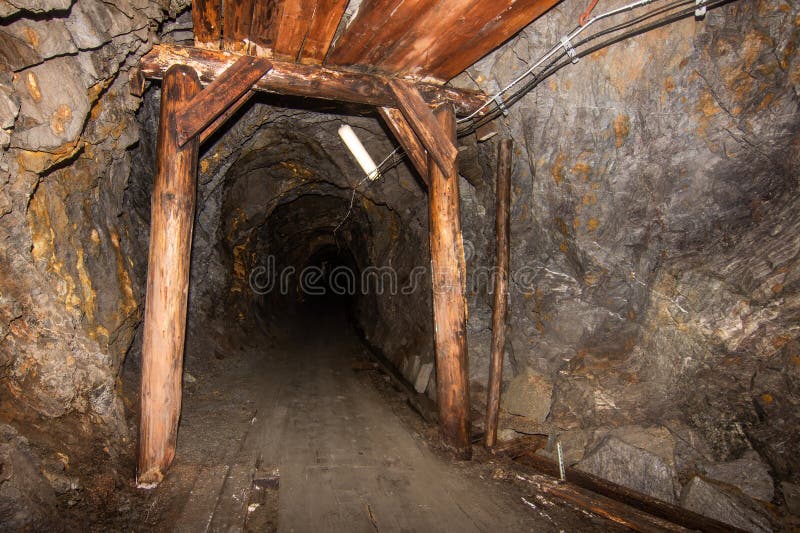Abandoned Gold Mine Remediation: Addressing A Toxic Legacy

Table of Contents
Environmental Impacts of Abandoned Gold Mines
Abandoned gold mines pose significant threats to the environment, leaving behind a complex array of contamination issues that require careful consideration and remediation. The impacts are long-lasting and far-reaching, affecting water resources, soil quality, and air quality.
Water Contamination
The leaching of heavy metals and the generation of acid mine drainage (AMD) are primary concerns in abandoned gold mine remediation. Heavy metals like arsenic, mercury, lead, and cadmium are highly toxic, even in small concentrations. AMD, a highly acidic water with high concentrations of dissolved metals, severely impacts aquatic ecosystems.
- Specific water contamination issues: Contamination of drinking water sources, disruption of aquatic life (fish kills, algal blooms), and the bioaccumulation of heavy metals in the food chain.
- Health risks associated with heavy metal exposure: Neurological damage, kidney failure, reproductive problems, and various cancers.
- Long-term effects on ecosystems: Habitat destruction, biodiversity loss, and the potential for long-term ecological damage.
Soil Degradation
Mining activities significantly alter soil properties, resulting in reduced fertility, increased erosion, and unstable landscapes. The removal of topsoil and vegetation, coupled with the exposure of underlying toxic materials, creates unstable conditions prone to landslides and erosion.
- Soil erosion consequences: Loss of fertile topsoil, sedimentation of waterways, and increased runoff.
- Loss of biodiversity: Destruction of habitats and the loss of plant and animal species.
- Challenges in soil rehabilitation: The difficulty of restoring soil structure, fertility, and microbial communities after extensive disturbance.
Air Pollution
Abandoned mines can also contribute to air pollution through dust generation, fugitive emissions (release of gases from mine workings), and the release of hazardous gases like radon and methane.
- Health effects of inhaling airborne pollutants: Respiratory problems, lung diseases, and other health issues.
- Examples of specific gases released: Radon (radioactive gas), methane (flammable gas), and hydrogen sulfide (toxic gas).
- Long-term respiratory issues: Chronic bronchitis, emphysema, and lung cancer.
Remediation Techniques for Abandoned Gold Mines
Effective abandoned gold mine remediation requires a multifaceted approach, employing a combination of passive and active techniques tailored to the specific site conditions and contamination levels.
Passive Remediation
Passive remediation methods utilize natural processes to treat contaminated water and soil. They are often cost-effective and require minimal ongoing maintenance.
- Constructed wetlands: Mimic natural wetlands to filter contaminated water, using plants and microorganisms to remove pollutants.
- Bioremediation: Employs microorganisms (bacteria and fungi) to break down pollutants in situ.
- Use of naturally occurring materials: Utilizing materials like limestone to neutralize AMD and reduce metal solubility.
- Advantages and disadvantages: Passive methods are generally low-cost and environmentally friendly, but they may be slower and less effective for severely contaminated sites. Their suitability depends heavily on site-specific factors.
Active Remediation
Active remediation methods involve direct intervention to remove or treat contaminants. These methods are generally more expensive and require more technological expertise.
- Chemical treatment: Neutralization of AMD using chemicals like lime, followed by precipitation of heavy metals.
- Excavation and removal of contaminated materials: Removing contaminated soil and water for treatment or disposal off-site.
- Use of engineered barriers: Constructing barriers (e.g., clay liners) to prevent the further migration of contaminants.
- Cost implications: Active methods are often costly, requiring significant investment in equipment, personnel, and disposal facilities.
Site Characterization and Risk Assessment
Before initiating any remediation efforts, a thorough site characterization and risk assessment are essential.
- Process involved: Detailed investigation of the site to identify the extent and nature of contamination. This includes soil and water sampling, analysis of contaminants, and assessment of potential environmental and human health risks.
- Crucial data to be collected: Information on the types and concentrations of contaminants, hydrogeology, and potential pathways of contaminant migration.
- Importance of risk assessment: To prioritize remediation efforts and select the most appropriate techniques.
Regulatory Frameworks and Funding for Abandoned Gold Mine Remediation
Successful abandoned gold mine remediation necessitates robust regulatory frameworks and adequate funding mechanisms.
National and International Regulations
Government agencies play a vital role in regulating mine remediation, setting standards for acceptable levels of contamination, and enforcing compliance.
- Examples of relevant legislation and regulations: Vary widely depending on the country and jurisdiction, but generally cover aspects such as permitting, monitoring, and enforcement.
- Importance of international cooperation: To share best practices and address transboundary pollution issues.
- Penalties for non-compliance: Can include fines, legal action, and the requirement for remediation at the responsible party's expense.
Funding Mechanisms
Securing adequate funding for remediation projects is a significant challenge.
- Government grants: Federal, state, or provincial government programs often provide funding for remediation projects.
- Private investment: Mining companies, responsible parties, or other private entities may contribute to remediation costs.
- Community involvement: Local communities can contribute through fundraising, volunteer work, and advocacy efforts.
- Challenges in securing funding: Competition for limited funds, bureaucratic processes, and the long-term nature of remediation projects.
Conclusion
Abandoned gold mines present a significant environmental challenge, impacting water quality, soil health, and air quality. Effective abandoned gold mine remediation necessitates a comprehensive approach that considers the specific site conditions, employs a combination of passive and active techniques, and is guided by thorough site characterization and risk assessment. Adequate funding and strong regulatory frameworks are crucial for successful remediation. Get involved in abandoned gold mine remediation projects in your community and help us leave a healthier planet for future generations. Learn more about effective abandoned gold mine remediation strategies today!

Featured Posts
-
 Ahmyt Sbayk Lastdaft Alaflam Alsewdyt
May 06, 2025
Ahmyt Sbayk Lastdaft Alaflam Alsewdyt
May 06, 2025 -
 The New Nike X Hyperice Collection Performance And Recovery Combined
May 06, 2025
The New Nike X Hyperice Collection Performance And Recovery Combined
May 06, 2025 -
 Kyf Tusahm Sbayk Fy Nmw Snaet Alaflam Alsewdyt
May 06, 2025
Kyf Tusahm Sbayk Fy Nmw Snaet Alaflam Alsewdyt
May 06, 2025 -
 Obraschenie Religioznykh Liderov Azerbaydzhana K Premer Ministru Velikobritanii Tekst I Analiz
May 06, 2025
Obraschenie Religioznykh Liderov Azerbaydzhana K Premer Ministru Velikobritanii Tekst I Analiz
May 06, 2025 -
 Suki Waterhouses Style The Retro Trainer Comeback
May 06, 2025
Suki Waterhouses Style The Retro Trainer Comeback
May 06, 2025
